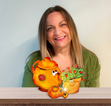Dawn Renee Stephens's Blog, page 9
February 7, 2022
12 Printable Valentines Cards Free
Get printable valentines cards free. Little Pot, Tea Pot, and Oil Lamp have a special gift for you this Valentine’s Day. It’s a set of 12 FREE printable valentines to share with your friends and family.
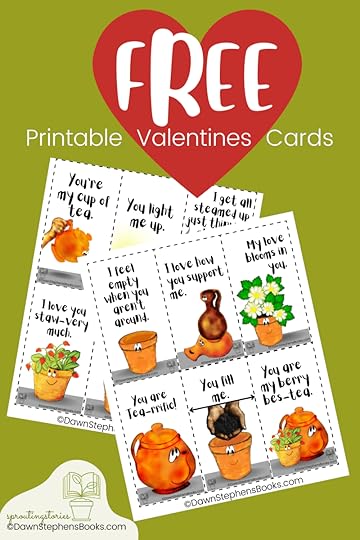 get these printable valentines cards free
get these printable valentines cards freeThe Little Pot, Tea Pot, and Oil Lamp are all vessels from books by Dawn Stephens. In these stories, the vessels discover why the potter made them. They learn how to be in a relationship with their maker and each other. Therefore, they are the perfect characters to help you wish friends and family a Happy Valentine’s Day.
To get the FREE PDF and print off your valentines, simply submit your first name and email. You will also be added to our mailing list and be able to get great deals from the Potter and His vessels. In the books about the potter and his vessels, children understand that the potter loves them because he made each one. You can read more about these stories here. I cannot wait to share them with you.
Printable Valentines Cards for FREEIn addition, if you are looking for a larger Valentine’s gift, giving a set of The Little Pot book alongside a clay pot filled with hearts and a plant is a great way to tell someone you love them. After all, Little Pot is all about growing the fruit of the Spirit and the fruit of the Spirit is LOVE.
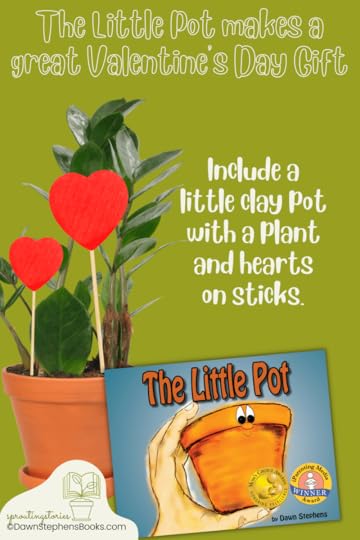 Give the Little Pot book for Valentine’s Day
Give the Little Pot book for Valentine’s DayLikewise, The Tea Pot book is a great gift too. Why not give the book with some tea to tell your valentine that you want to share tea time and read with them too?
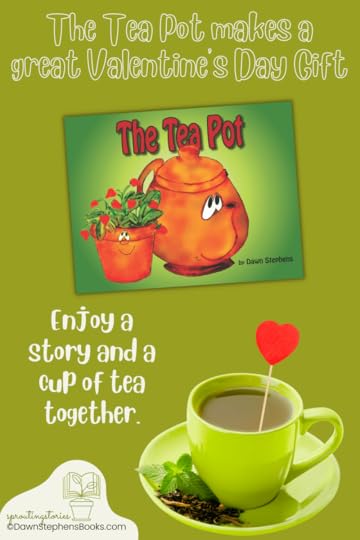 Share The Tea Pot book and a cup of Tea with your valentine.Want to know the steps to grow fruit of LOVE? Little Pot and I can show you.
Share The Tea Pot book and a cup of Tea with your valentine.Want to know the steps to grow fruit of LOVE? Little Pot and I can show you.
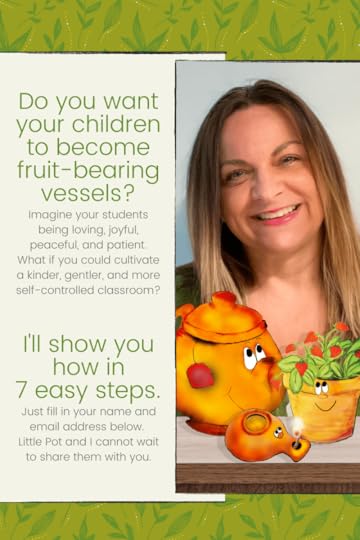
The post 12 Printable Valentines Cards Free appeared first on DawnStephensBooks.
January 31, 2022
Little Miss Muffet Lyrics to Compare 5 Aspects of Insects and Spiders
A great way to compare and contrast insects and spiders is to use the book Little Miss Muffet Learns About Spiders. Similarly, The Little Miss Muffet Lyrics in this book illustrate five differences between insects and spiders.
The Original Little Miss Muffet LyricsLittle Miss MuffetSat on a tuffet,
Eating her curds and whey;
Along came a spider,
Who sat down beside her,
And frightened Miss Muffet away.
The poem dates back to the early 19th century in England. Consequently, many people believe that Little Miss Muffet is about a girl named Patience who was Thomas Muffet‘s step-daughter. However, Thomas was a scientist from the 16th century who studied insects and spiders and their effects on medicine.
1. Firstly, insects and spiders have different body parts.“You’re not a bug,”She said with a shrug,“Compare the two bodies and see.”“On spiders like youThe parts number two,but all of the insects have three.”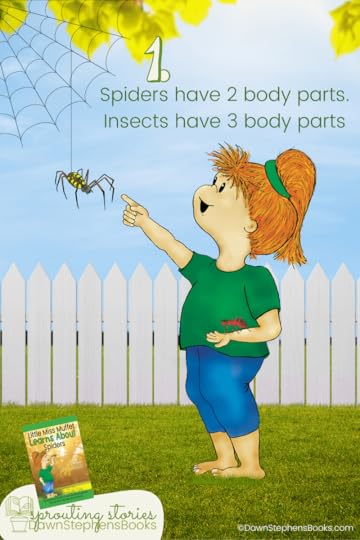 A spider is not an insect. It has 2 body parts and insects have 3.2. Secondly is the number of legs on insects and spiders.The spider said “Grand. But please understand, Here’s the best way to separate.” “When it comes to feet, We have them all beat.Bugs have only six; spiders: eight.”
A spider is not an insect. It has 2 body parts and insects have 3.2. Secondly is the number of legs on insects and spiders.The spider said “Grand. But please understand, Here’s the best way to separate.” “When it comes to feet, We have them all beat.Bugs have only six; spiders: eight.”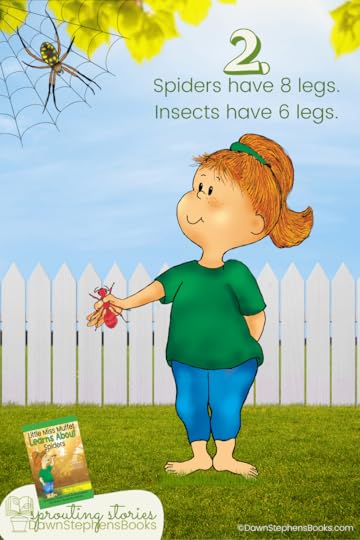 A spider has 8 legs, while an insect only has 6.3. Thirdly is the number of eyes insects and spiders have.“And look at my eyes;Is that a surprise?I hope you will think it first-rate.”“If you think I’ve two,Then I have tricked you.Look closely and you will see eight.”
A spider has 8 legs, while an insect only has 6.3. Thirdly is the number of eyes insects and spiders have.“And look at my eyes;Is that a surprise?I hope you will think it first-rate.”“If you think I’ve two,Then I have tricked you.Look closely and you will see eight.”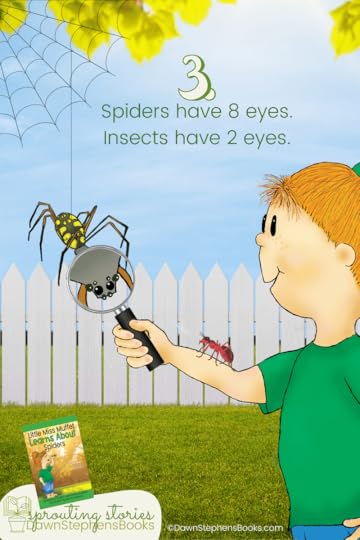 Little Miss Muffet discovers that spiders can have 8 eyes.4. Spiders and some Insects spin webs.“And the web that you spin,Strong, sticky, and thin,Is useful to catch little flies.”
Little Miss Muffet discovers that spiders can have 8 eyes.4. Spiders and some Insects spin webs.“And the web that you spin,Strong, sticky, and thin,Is useful to catch little flies.”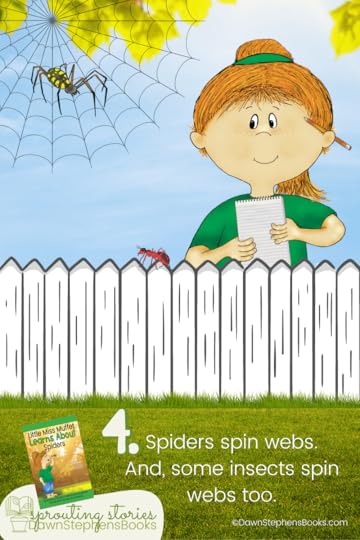 Some insects spin webs like spiders.5. Lastly, only a few spider and insects are poisonous.Many books have toldAbout spiders, so bold,Who carry a poisonous bite.But most will not harmYour leg or your armAnd usually come out at night.
Some insects spin webs like spiders.5. Lastly, only a few spider and insects are poisonous.Many books have toldAbout spiders, so bold,Who carry a poisonous bite.But most will not harmYour leg or your armAnd usually come out at night.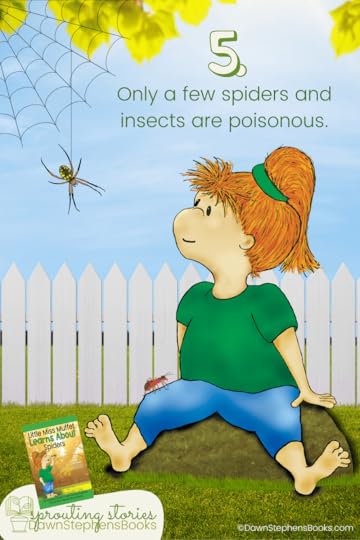 Just a few spiders and insects are poisonous.Little Miss Muffet Learns About Spiders and other Resources
Just a few spiders and insects are poisonous.Little Miss Muffet Learns About Spiders and other ResourcesThis creative teaching resource uses Little Miss Muffet to teach children all about insects and spiders. It is a part of The Mother Goose Meets other Nature book series.
After sharing these books with teachers and home-school parents, we discovered a need for a teacher’s guide and additional resources for each book. Subsequently, we created teacher guides too. And because Little Pot believes that spiritual, social, and academic growth produce the fruit of the Spirit, each guide contains these three sections. A new guide will be released each month as follows.
September: (Routines and Schedules) “Hickory, the Mouse Learns About Time” and “Teach About Time with Hickory, the Mouse”.
October: (Pumpkins) “Peter-Peter Learns About Decay and Growth” and “Teach About Decay and Growth with Peter-Peter”.
November: (Healthy eating habits) “Jack Sprat Learns About Food” and “Teach About Food with Jack Sprat”.
December/January: (Snow and ice, States of Matter) “Jack and Jill Learn About Water” and “Teach About Water with Jack and Jill”.
February: (Shadows) “Jack B. Nimble Learns About Shadows“ and “Teach About Shadows with Jack B. Nimble”.
March: (Animals and Habitats) “Mary Learns About Animal Coverings” and “Teach About Animal Coverings with Mary”.
April: (Insects and Spiders) “Little Miss Muffet Learns About Spiders” and “Teach About Spiders with Little Miss Muffet”.
May: (Life Cycles and Positional Words) “Humpty Dumpty Learns About Positions” and “Teach About Positions with Humpty Dumpty”.
Sign up for the 7 steps to become fruit-bearing vessels and we will notify you each month when a new teacher’s guide is released.

The post Little Miss Muffet Lyrics to Compare 5 Aspects of Insects and Spiders appeared first on DawnStephensBooks.
January 24, 2022
3 Ways to Grow Using a New Nursery Rhyme
Children need to grow spiritually, socially, and academically. These are the three areas that allow us to become fruit-bearing vessels. Children also learn and grow with nursery rhymes. Therefore, Dawn Stephens has taken a traditional nursery rhyme and created a new nursery rhyme that will help children to grow in these three areas.
A New Nursery Rhyme for Jack Be NimbleIn the new nursery rhyme created for Jack Be Nimble, Jack is not jumping over a candlestick. He wants to jump over his shadow. Therefore, the rhyme and lessons surrounding Jack Be NImble teach students about shadows. Teachers and students can use this new nursery rhyme and lesson to grow three ways.
These three areas are more specifically described in the whole child approach and the holistic education model.
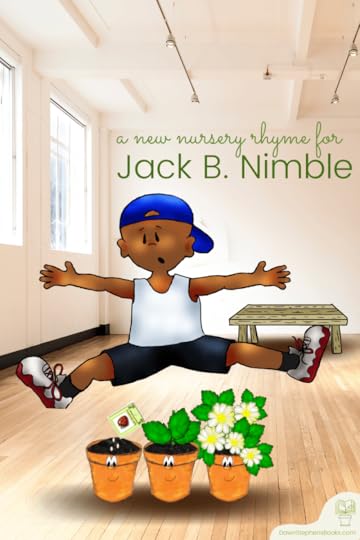 In this new nursery rhyme, Jack tries to jump his shadow. The teacher’s guide provides ways for students to grow spiritually, socially, and academically.1. Spiritual Growth using Jack Be Nimble
In this new nursery rhyme, Jack tries to jump his shadow. The teacher’s guide provides ways for students to grow spiritually, socially, and academically.1. Spiritual Growth using Jack Be NimbleWhen children gain an understanding of the benefits of a shadow, they find opportunities for spiritual growth. After helping them recognize that shade is nothing more than a shadow, they can brainstorm how shade can be comforting on a very hot day. They can learn how shade shelters them from the hot sun. Psalm 91:1 is a wonderful verse to share with them when they are learning about shadows. After reading this verse, children will see that we can rest in God’s shadow. They can then see that just as the shadow of a tree, building, or beach umbrella can protect us from the harmful rays of the sun, God’s shadow can protect us from harmful things. We live in a time when fear controls many of our decisions. Being in the “Shadow of the Almighty” means we do not need to be afraid.
Another example of spiritual growth using shadows can be found here. I wrote this blog about spiritual shadows and light as I was writing the Jack Be Nimble book.
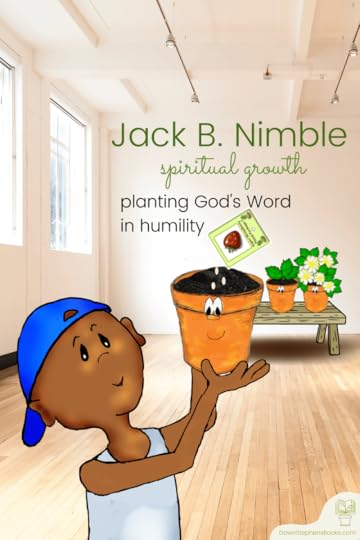 Spiritual growth happens when we plant God’s Word in humility. Jack uses lessons on shadows to grow spiritually.2. Social Growth with Jack Be Nimble
Spiritual growth happens when we plant God’s Word in humility. Jack uses lessons on shadows to grow spiritually.2. Social Growth with Jack Be NimbleThe wonderful thing about shadows is that they resemble their source. Your shadow is unique because you are unique. As Jack Be nimble learns about shadows, he discovers how shadows are made and that they move with their source. By learning to appreciate the shadows we make, children learn to appreciate each other too. Creating fun activities with shadows like shadow dancing, shadow tracing, and guessing whose shadow is whose will provide opportunities for social growth.
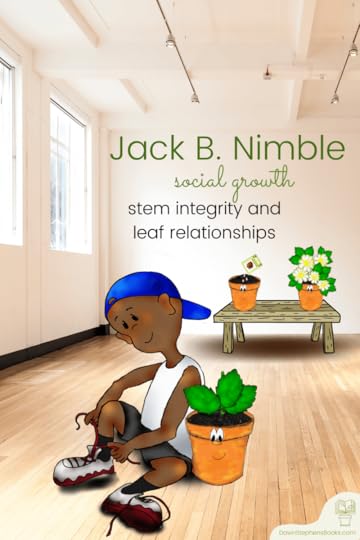 Jack grows socially when he stems integrity and forms good relationships. These lessons on shadows provide opportunities for social growth.3. Academic Growth with the New Nursery Rhyme of Jack Be Nimble.
Jack grows socially when he stems integrity and forms good relationships. These lessons on shadows provide opportunities for social growth.3. Academic Growth with the New Nursery Rhyme of Jack Be Nimble.As children study shadows they learn about the earth’s movement in relation to the sun. Lessons on shadows make a great segway to learning about how we can make things move. Children usually focus on moving an object with force. For example, they push or pull things to change the location of an object. A shadow, however, can be moved without direct contact. Children must learn how to manipulate the position of an object to a light source in order to make its shadow move. Likewise, a child can make the size of a shadow change too. Manipulating shadows can integrate science, literacy, mathematics, and art.
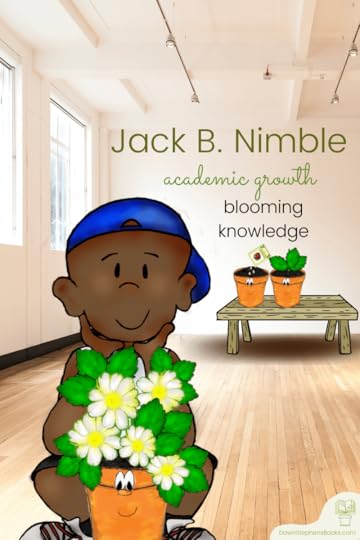 Jack blooms knowledge about shadows and grows academicallyLearning with Jack Be Nimble
Jack blooms knowledge about shadows and grows academicallyLearning with Jack Be NimbleDawn Stephens Books provides a full-color printable book with a new nursery rhyme for Jack Be Nimble. A twenty-page teacher’s guide also provides lessons that are geared specifically to spiritual, social, and academic growth. YOu can purchase the book and teachers guide on Teachers Pay Teachers.
Find other nursery rhymes with new lyrics that can provide spiritual, social, and academic growth here. Sign up below for our free growth model below.
Download a FREE copy of the model here.If you want to read more on this topic, check out the Helpful Professor.
The post 3 Ways to Grow Using a New Nursery Rhyme appeared first on DawnStephensBooks.
January 17, 2022
12 Creative Centers to Build Social Skills for Preschool
Social Skills for preschool are something that early childhood teachers think about daily. Therefore, a big part of what happens in preschool is the building of social skills. Because interactive play develops social skills best, creating new and different situations for children to play with each other is essential to a child’s social development. Achieve this by establishing centers.
What are Centers in Preschool?Centers are areas in the classroom where children can play and learn together. Each center usually has a theme or specific type of activity for the children to do. Some preschools refer to two types of centers: play centers and learning centers. However, children learn through play. Therefore, we believe that they should be one and the same. Consequently, social skills require preschoolers to learn and play together.
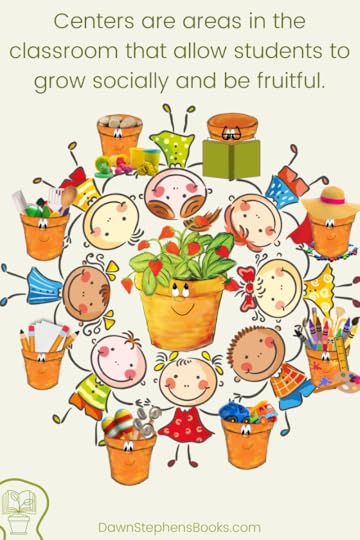 what are centers in preschool? Centers allow students to grow socially.Social Activities for Preschool
what are centers in preschool? Centers allow students to grow socially.Social Activities for PreschoolWe have come up with twelve different centers that we feel provide social preschool activities. A preschooler’s social-emotional development is a part of the whole child approach and the holistic education model.
1. Art CenterAn art center is an excellent place to develop social skills for preschool. It is an area designed to create. Fill this area with various utensils for creating pictures such as crayons, markers, and paints. It should also contain a table and easel because children should explore creating art individually and with partners. Glue. scissors, rulers, construction paper, and magazine pictures are also great tools to have on hand. Every now and then, it can be fun to add new material to see what the students can create with it.
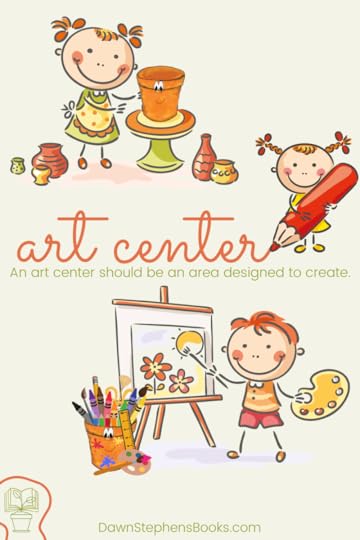 an art center should encourage students to create original pieces of art2. A Music Center can build social skills in preschoolers
an art center should encourage students to create original pieces of art2. A Music Center can build social skills in preschoolersA music center is a great place for children to create and listen to songs. A TV screen can play music. It should also contain instruments that allow the children to play rhythms and notes. With music goes dancing. Therefore, allow the music center to be in an area large enough for twirling and jumping.
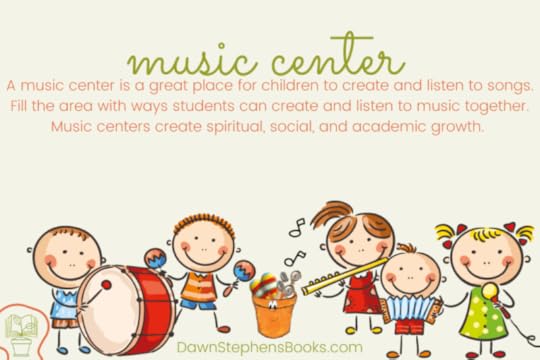 Making music together creates social growth.3. A Transportation Center encourages social skills for preschool
Making music together creates social growth.3. A Transportation Center encourages social skills for preschoolFill this center with toy trucks, cars, trains, and planes. It is a great idea to have a map rug that allows the children to move the vehicles across roads. A train table with wooden tracks is also a great way for children to build social skills while playing and learning in this area.
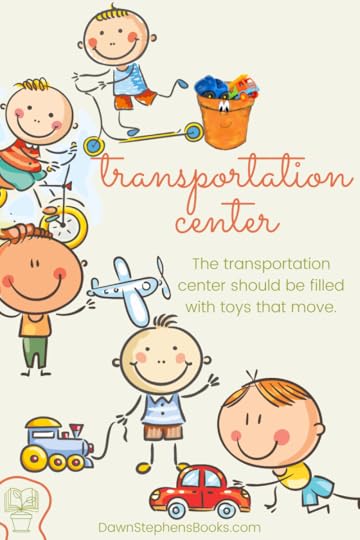 The transportation center should be filled with toys that move.4. A Block Center allows preschoolers to build towers and social skills
The transportation center should be filled with toys that move.4. A Block Center allows preschoolers to build towers and social skills Sometimes known as a construction center, this area should contain building materials such as wooden blocks, legos, or even cardboard boxes. Tool belts with toy screwdrivers and hammers can also be a fun addition to this center. As children build and tear down their creations, they learn how to share in achievements and disappointments.
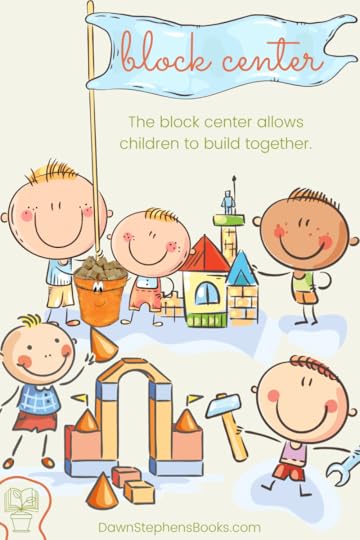 The block center is an area that students can build together.5. Cooking Center
The block center is an area that students can build together.5. Cooking CenterActual cooking or pretend cooking can take place here. A toy kitchen filled with pots and pans, dishes, and toy foods will enhance a child’s imagination. A table and chairs are also a must so that the children can sit and eat together.
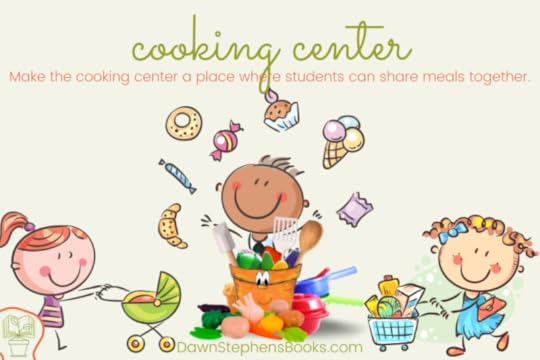 A cooking center is a great place for socialization.6. Dress-Up Center
A cooking center is a great place for socialization.6. Dress-Up CenterThis center can be combined with other centers. It is sometimes called dramatic play. Having it as its own are, however, allows students to dress up and become anything they want. Fill the area with costumes, clothes, hats, shoes, and bags. It is a good idea to also put dolls in this center with clothes that the students can dress them in as well.
7. Sensory CenterThis center should contain items that will stimulate their sense. This is where sand, rice, or water tables should be. It might contain playdough or materials that are furry or prickly. containers filled with items that have different smells are also a great addition to this center. A lot of times this is a great spot for students to release anxiety and relax.
8. Reading CenterThis center should be filled with comfortable seats and a lot of books. Young children read pictures before words. Therefore, fill this center with a lot of picture books that the students can read to one another. It is also a great spot to work on word-building activities.
9. Game and Puzzle CenterLikewise, the word-building activities can be placed in a game and puzzle center. Fill this area with age-appropriate puzzles and games. Preschool children love the idea of games and this is a great area to make learning feel like a game. Also, this is an area where you can encourage children to match shapes and colors, count objects, and take turns.
10. Social Studies CenterThis is a center designed specifically for learning about social skills. This center might contain dollhouses and dolls that allow children to act out and create relationship scenarios. Maps and globes can also be a part of this center. Children will learn about different countries and cultures. As a result, they will be encouraged to pretend with new plots and settings.
11. Writing CenterAlways encourage students to write. This is different from the art center where the focus is drawing and painting. In this center, the focus is on writing letters and numbers. Therefore, journals, chalkboards, whiteboards, and all types of paper should be supplied for children to explore and practice their own writing.
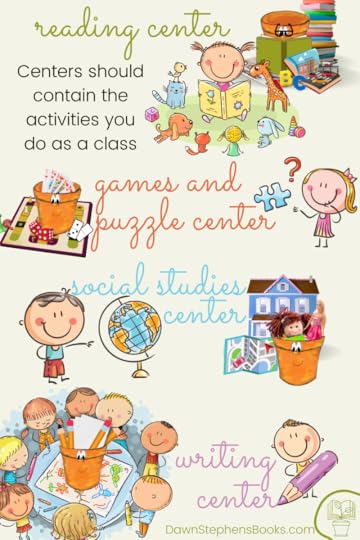 Anything you do as a class should be added to the centers.12. Puppet Center
Anything you do as a class should be added to the centers.12. Puppet CenterFinally, the puppet center is an area where children can perform and share different stories. Filling this center with puppets of all kinds and a stage will allow children to grow more social skills. Puppets can be hand puppets, finger puppets, or stick puppets. In addition, it might surprise you how much a child expresses his feelings through the use of a puppet.
Social skills for preschool are not all that centers accomplish.In addition, Little Pot has created center signs that list objectives for each area of growth. You can purchase full-color versions to print on legal paper here. To learn more about spiritual, social, and academic growth with Little Pot download a free copy of our growth model below.
Download a FREE copy of the model here.If you want to read more on this topic, check out the Helpful Professor.
The post 12 Creative Centers to Build Social Skills for Preschool appeared first on DawnStephensBooks.
January 10, 2022
New year New goal – 5 steps to accomplish successful and fruitful goals
A new year. A new goal. Ever wonder why we all love to set new goals in the new year?
What’s new year resolution?New Year’s resolution history is fascinating. As with most of our modern-day traditions, we can trace them back to pagan worship. It was the Babylonians who are believed to be the first people to make New Year’s resolutions. History.com has a fascinating article all about it.
Are New Year’s resolutions biblical then? After all, goal setting is a healthy practice we should all take part in. Biblically, we need to make sure that we commit whatever we do to the Lord and let Him establish our plans (Proverbs 16:3). There are many more bible verses that give wisdom to planning and goal setting also. Therefore, I do not think that setting goals or even New Year’s resolutions are wrong, as long as we keep in mind that God wants to work in and through our lives. He wants us to partner with Him for our own growth, not just spiritually, but socially, and academically. All three of these areas of growth are important in the fruit-bearing process. Using these steps, we can then set successful and fruitful goals.
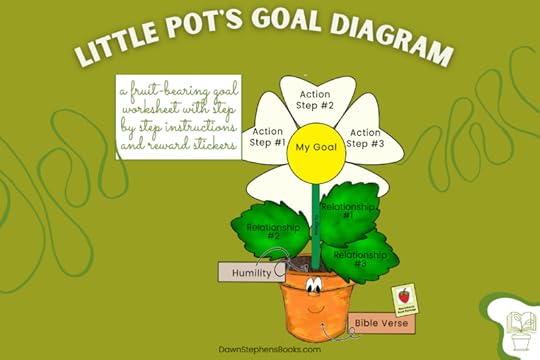 You can purchase Little Pot’s complete goal diagram by clicking on this image.
You can purchase Little Pot’s complete goal diagram by clicking on this image.We will be following the steps in reverse. Educators know this technique as “backward planning”
Step 1. Identify the goal and the action steps. (Bloom Knowledge)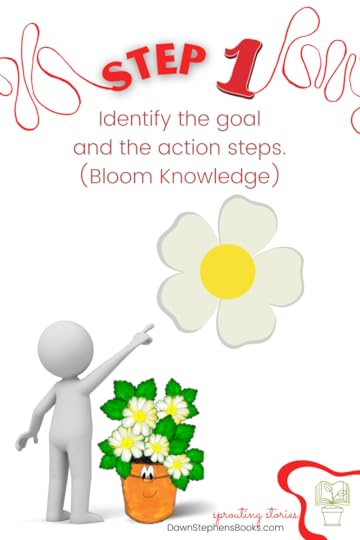 step 1 is to identify the goal and create action steps.
step 1 is to identify the goal and create action steps.In the center of the flower, have the students write a goal to be more fruitful. We can confidently know that God is able to grow HIs fruit. Therefore, whatever characteristic of the fruit of the Spirit they choose, the sentence should read, ” I know God will grow __(love, joy, patience, self-control, etc.)__ in me by _(date)__. The fruit grows in seasons. Therefore, this must be a timed goal and needs an end date. Some students may work to accomplish their goal in one week or for three days. Others may set goals lasting a month or six weeks. It just depends on the child’s age and specific goal.
While God grows the fruit, however, they are responsible for the actions or work it requires. Next, they need to write one to three action steps inside the pedals. Here are some examples of ones that I wrote with children over the years.
“I know God will grow patience in me by (end date)”.Raise my hand before I speak.Let my friends be first in line.Patiently wait my turn at the water-fountain.“I know God will grow kindness in me by (end date)”.Share the math tubs with friends.Say nice things to my classmates.Keep my hands to myself and not hit.“I know God will grow self-control in me by (end date)”.Complete my morning work every day.Not get upset if others do not play fair at recess.”Not play in the restroom.Note: Some students may need to focus on only one action step.
The action steps should be relevant to each child’s abilities. If the end date comes and the child has not completed an action step correctly, set a new goal with that specific action step being accomplished in a shorter time frame. Step 5 will allow you to celebrate all fruit-bearing that takes place.
Step 2. Identify people in your life that can help you achieve this goal. (Leaf Relationships)In Little Pot’s fruit-bearing model, the leaves represent relationships. Everyone knows that if you share your goal with someone, you are more likely to achieve it. Therefore, have the child select two or three people they can lean on as they complete each action step. They should be able to identify exactly how the person they have chosen can help them. Set a time for them to ask each person if they are willing to help and take part in their goal. God sometimes using difficult relationships as our most fruitful opportunities. This step is a great way for classmates to work at getting along too. If two friends need to work at being kinder to each other they may each be a leaf on the other one’s diagram. Counselors and student advocates are sometimes great accountability partners too. Here are a few more examples:
“Samuel can help by not sitting next to me at the carpet because I like to talk to him.”“My mom can help me by waking me up earlier so I will not be late each day.”Mrs. Jones can help by giving me the single to raise my hand if I begin to talk our of turn.”“Cindy can help me by reminding me to get all my supplies before we begin to work.“Mrs. Jones can help me by giving me quiet corner to work in by myself.”Pastor Tim can help by praying for me every day this week.”Note: Remind students that it is never anyone else’s fault if they do not meet the goal. If at the end date, the person has not been helpful or done what they promised, they can set a new goal and choose a new person. We sometimes must pluck leaves off of plants if they are not healthy.
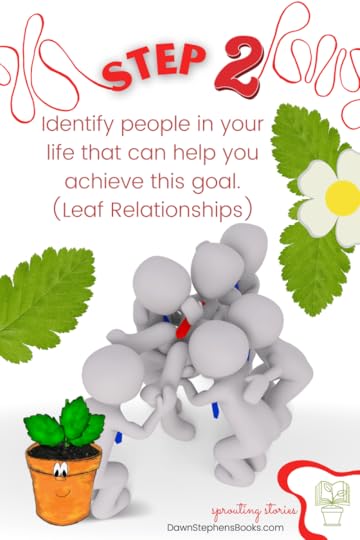 Step 2 is to identify people that can help you be successful.New Year New Goal – Step 3. Commit to it. (Stem integrity)
Step 2 is to identify people that can help you be successful.New Year New Goal – Step 3. Commit to it. (Stem integrity)The stem of Little Pot’s fruit plant represents integrity. Integrity is required in any goal and being honest with themselves and others is a big part of achieving goals. Some of the action steps may be hard to monitor. Therefore, students must be honest and trustworthy. Remind them that the stem is what connects the different pieces of the fruit plant. Likewise, their integrity is what will connect all the parts of their goal. It is important that they have strong integrity for the duration of the goal.
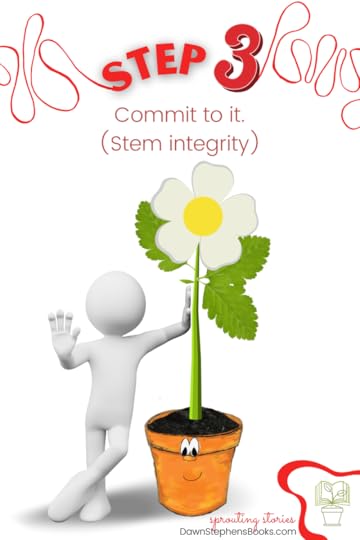 Step 3 is to commit with integrity.Step 4. Be humble and plant scripture. (The soil and the seed)
Step 3 is to commit with integrity.Step 4. Be humble and plant scripture. (The soil and the seed)The humus or good soil in Little Pot represents our humility. This is one of the most difficult steps for a child to complete. It is difficult for children to admit why they need to set a goal. However, it is an important part in their journey. In some cases, it may be necessary to start with this step. Lovingly help them to see the area they need improvement in and record why they need ot set the goal in the first place.
Once they have realized their own need for the goal, find a Bible verse that relates to the situation. Below are some verses that can connect the different charateristics of the fruit of the Spirit. You may even choose to have the child recite the verse for memory on the end date.
Love: John 15:9; 1 Corinthians13; 1 John 4:19Joy: Psalm 71:23; John 16:22-24 Peace: Romans 12:18, 14:9; 1 Corinthians 14:33; Philippians 4:6-7 Patience Proverbs 14:21; 15:18; 28:11; 1 Thes. 5:14; James 5:8-9Kindness: Proverbs 11:16,17; Jeremiah 9:23-24; Luke 6:31; Job 6:14Goodness: Psalm 23:6; Ephesians 5:8-10; Galatians 6:9,10Faithfulness: Proverbs 3:3, Matthew 23:23; Revelation 2:10bGentleness: Proverbs 15:1; Colossians 3:12, Philippians 4:5,1 Peter 3:15Self-control: Proverbs 25:28, Proverbs 29:11, Titus 2:11-12, 1 Peter 4:7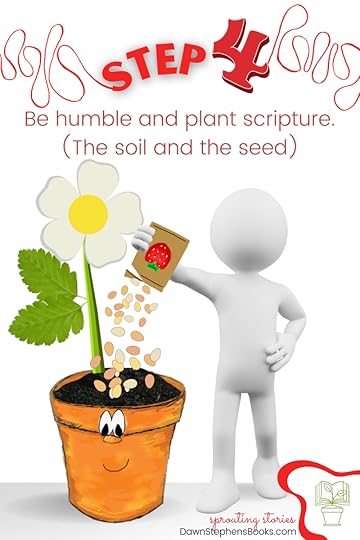 step 4 is to humbly support your efforts with scripture.Step 5. Celebrate the result. (Bear Fruit)
step 4 is to humbly support your efforts with scripture.Step 5. Celebrate the result. (Bear Fruit)When the end date arrives and the child has accomplished the goal, celebrate how God grew the fruit through and in them. This is a great way for children to practice giving God the praise for the good things that happen in their life. For example, in my prinicpal’s office. I would reward the student with a strawberry sticker and we’d turn on music and dance. Recognition can also be given out at school assemblies, chapel, or class worship times. Achieving a goal is no small feet. Consequently, the more we celebrate with children, the more eager they will be to set their next goal!
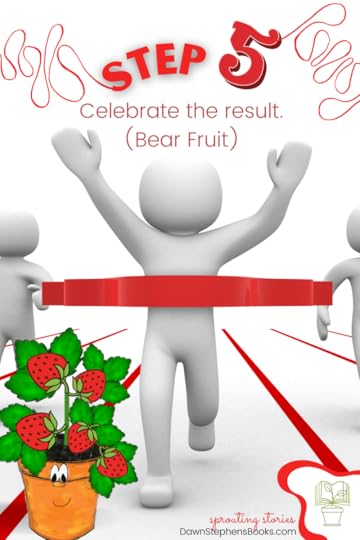 Step 5 is to celebrate the results.
Step 5 is to celebrate the results.You can purchase the full Goal Diagram that includes more detailed instructions, a goal worksheet for students, and reward stickers here.
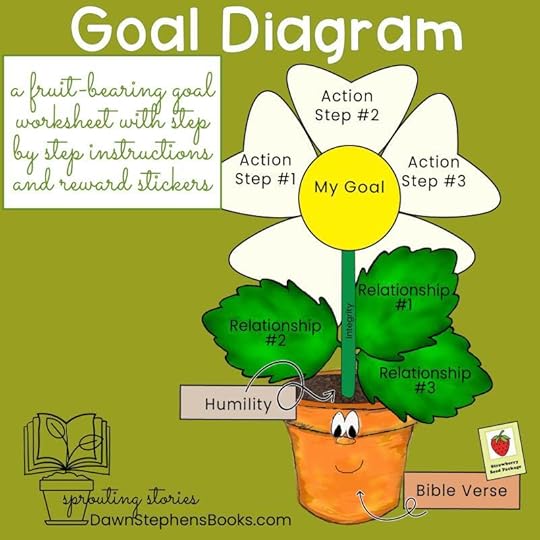 More on How to Grow the Fruit of the Spirit
More on How to Grow the Fruit of the SpiritWant to understand more about how you can help your children grow the fruit of the Spirit? For example, are you hoping their goals are more loving, joyful, peaceful or patient? Similarly, they become kinder, gentler, and show more self-control. These are not just character traits. They are qualities that are produced through us by the Holy spirit. But, what if you could help cultivate love, joy, peace, patience, kindness, goodness, faithfulness, gentleness, and self-control in your child? I’m here to tell you, You can!
Helping children understand how to become fruit-bearing vessels is a God-sized calling and it is one of the most important things we can do as parents and educators.
This model works! It works because it follows scripture and I have seen how God has used it to produce the fruit of the Spirit through me and the teachers, parents, and students I have worked with.
Furthermore, I will show you how spiritual, social, and academic growth will lead to fruit-bearing. We will provide you with a curriculum and lessons that specifically follow this process. Above all, being a fruit-bearing vessel is what I strive to do every day. It is the thing I’m most passionate about.
If you join me on this fruit-bearing journey, I promise that together we will see how God is at work in the lives of your children.
The post New year New goal – 5 steps to accomplish successful and fruitful goals appeared first on DawnStephensBooks.
December 27, 2021
How the Whole Child Approach Promotes Holistic Thinkers in Christian Education
Holistic thinkers focus on the big picture. Education, however, often focuses on the details of subject matter and how well a child has learned a specific skill. Because Christian education often prides itself in high academics, it sometimes finds itself in disagreement with the whole child approach. Therefore, a clear understanding of the definition is important.
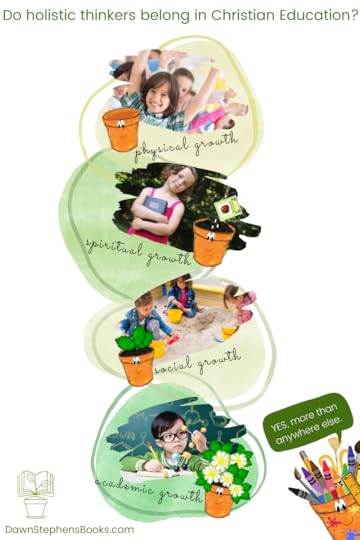 Definition of Holistic Education
Definition of Holistic EducationHolistic education is an approach that teaches the whole child. The physical, ethical, social/emotional, and academic development is taught through integrated subjects.
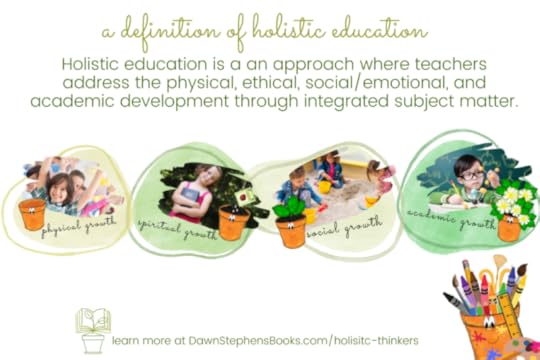 What is Holistic Education?
What is Holistic Education?According to Wikipedia,
“Holistic education is a relatively new movement in education that seeks to engage all aspects of the learner, including mind, body, and spirit. Its philosophy, which is also identified as holistic learning theory, is based on the premise that each person finds identity, meaning, and purpose in life through connections to their local community, to the natural world, and to humanitarian values such as compassion and peace”.
If you read the entire article, you will find that some make a connection of holistic thinking to evolution and socialism.
Evolution and Socialism? I know, I know, … if you’re a part of a Christian educational system, you’ve read those two connections and immediately thought “Nope, not for me.” But, before you stop reading and consider me misguided or unholy, first consider what holistic thinking actually is. Once you do, I believe you’ll agree that Christian education should agree with aspects of holistic thinking.
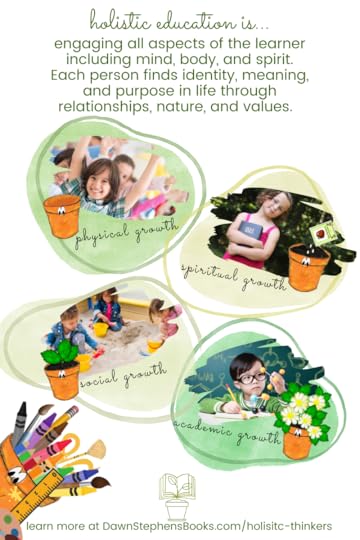 Jesus and Holistic Thinkers
Jesus and Holistic ThinkersI believe that Jesus, himself, is a holistic thinker. He was concerned about every aspect of our development. After all, He told us to love God with all of our heart, soul, strength, and mind (Matt. 22:37; Luke 10:27). We also read that Jesus grew in wisdom, stature, and favor with God and man (Luke 2:52). These verses tell us that physical, spiritual, social, and academic growth are important. Therefore, they should be very important in Christian education!
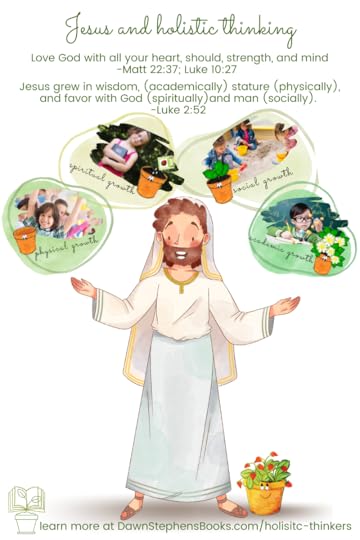 Scriptures tell us that Jesus thought holistically.The Perfect Model for a Holistic Thinkers in Christian Education
Scriptures tell us that Jesus thought holistically.The Perfect Model for a Holistic Thinkers in Christian EducationWe’ve made the perfect model to follow. This method helps teachers, parents, and students understand why physical, spiritual, and social growth are as important as academic growth. After using this model in a Christian school, some of the teachers and parents were concerned that our academic results on standardized tests would fall. However, the exact opposite happened. The stakeholders discovered that when we emphasized spiritual and social growth, the academic grew stronger and more consistently. It all makes sense when you consider the six developments to producing the fruit of the Spirit. These six steps can be grouped into the areas of physical, spiritual, social, and academic growth.
Holistic Growth ModelPhysical Growth helps students to know who they are in Christ. Furthermore, they learn to appreciate their uniqueness.the potter creates a vesselSpiritual Growth allows students to humbly receive the Word of GodThe vessel is filled with humus. Humus is good soil and represents humilityA seed is planted. The seed represents God’s Word.Social Growth emphasizes the student’s integrity and relationships A straight, upright stem grows (representing our integrity)Likewise, leaves form to begin the process of photosynthesis, making food for the plant with light. Relationships give us the light of Christ.Knowledge is bloomed through academic growth.A flower blooms to pollinate the plant. It attracts insects, just as the knowledge we bloom attracts others and reproduces new ideas. Flowers bloom at different seasons and rates. We bloom knowledge at different times also.Fruit is produced.Once the vessel contains humus soil, has seeds planted, grows a stem and leaves, and blooms a flower, it can produce fruit. Likewise, when we humbly plant God’s Word (spiritual growth), stem integrity, leaf relationships (social growth), and bloom knowledge (academic growth), we produce the fruit of the Spirit.Jesus knew that it takes all areas of growth to become a fruit-bearing vessel. Therefore, Christian education should use the whole child approach and promote holistic thinkers!
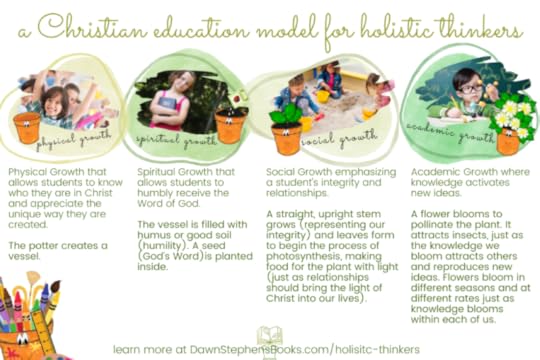 Download a FREE copy of the model here.
Download a FREE copy of the model here. If you want to read more on this topic, check out the Helpful Professor.
The post How the Whole Child Approach Promotes Holistic Thinkers in Christian Education appeared first on DawnStephensBooks.
December 13, 2021
What Does 12 Days of Christmas Mean to Creative Christians?
What does 12 days of Christmas mean? The time between the birth of Christ and the day the Magi or three kings were said to arrive in Bethlehem is what most people consider the 12 days of Christmas.
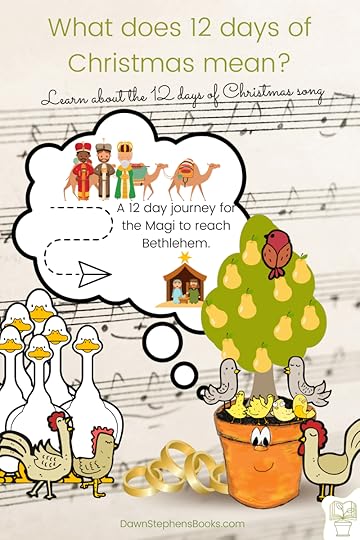 The 12 days represent a 12 day journey for the Magi to reach Bethlehem.When do 12 days of Christmas start?
The 12 days represent a 12 day journey for the Magi to reach Bethlehem.When do 12 days of Christmas start?The 12 days of Christmas start on Christmas Day when Jesus is born. Most celebrate this day on December 25th.
When do 12 days of Christmas end?The 12 days of Christmas end on January 6th, twelve days after Jesus was born. It is believed that the wisemen or magi would have traveled for twelve days. January 6th is known as The Epiphany or Three Kings Day. In some regions of Spain, Europe, and Latin America it is more widely celebrated than Christmas Day.
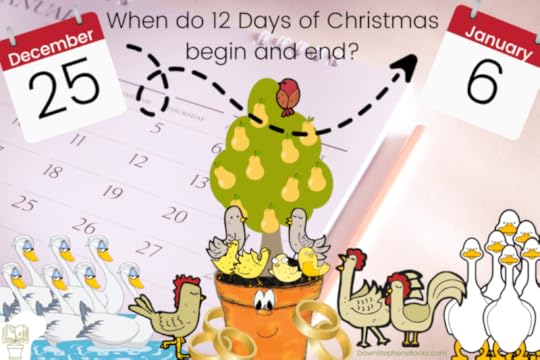 The 12 days of Christmas begin Dec. 25 and end Jan. 612 Days of Christmas Religious Meaning
The 12 days of Christmas begin Dec. 25 and end Jan. 612 Days of Christmas Religious MeaningNo one knows exactly when and why the song was written. Most believe it began as a children’s memory game in French. Around 1780 an English version was first printed in the children’s book, Mirth without Mischief. It was a poem without music where children played a game reciting each new phrase while remembering the previous one.
The actual items of each day have changed with different versions.
In 1979, a Canadian hymnologist, Hugh D. McKellar said the 12 Days of Christmas lyrics were a way for Christians to learn about their faith from 1558 to 1829. During this time, Christianity was against the law. therefore the 12 days of Christmas was type of secret code that represented different aspects of the Christian faith. There was no evidence given for this claim, however. In 1982, however, Hal Stockert wrote an article suggesting the use of the twelve gifts could be used to teach different aspects of the Christian faith.
Religious Meanings to the 12 Days of ChristmasThe partridge in the pear tree represents JesusThe 2 turtle doves signifying the Old and New Testament. The 3 French hens are Faith, Hope and Charity, The 4 calling birds are the four gospels.The 5 golden rings are reportedly the first five books of the Old TestamentThe 6 geese represent the six days of creation The 7 swans are the gifts of the Holy Spirit, The 8 maids are the eight blessings Jesus gave at the Sermon on the MountThe 9 ladies dancing are the nine different fruits of the Holy SpiritThe 10 lords are the Ten CommandmentsThe 11 pipers represent the eleven faithful apostlesThe 12 drummers drumming are the twelve points of the doctrine in the Apostle’s Creed.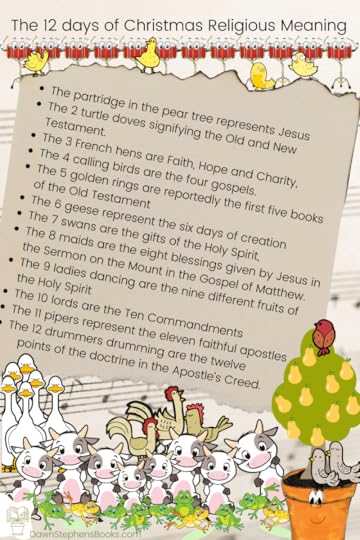 The different gifts have been said to secretly represent something about Christianity. The Lyrics
The different gifts have been said to secretly represent something about Christianity. The LyricsWhat are 12 days of Christmas lyrics? The lyrics to the 12 days of Christmas have changed over the years. Wikipedia offers an excellent chart of the different variations. Also, Dawn Stephens Books offers a coloring book with Little Pot for the 12 days of Christmas. Consequently, the images follow these lyrics:
Download a FREE copy of the Lyrics and a coloring sheet.On the 1st day of Christmas, the potter gave to me 1 partridge in a pear tree.
-Little Pot’s 12 Days of Christmas
On the second day of Christmas the potter gave to me 2 turtle doves,
and I partridge in a pear tree.
On the 3rd day of Christmas the potter gave to me 3 French hens, 2 turtledoves,
and 1 partridge in a pear tree.On the 4th day of Christmas, the potter gave to me 4 calling birds, 3 french hens, 2 turtledoves, and 1 partridge in a pear tree.
… continuing through …
On the 12th day of Christmas, the potter gave to me 12 drummers drumming, 11 pandas
piping, 10 frogs a leaping, 9 dancers dancing, 8 cows a milking, 7 seven swans a swimming,
6 geese a laying, 5 golden rings, 4 calling birds, 3 french hens, 2 turtledoves,
and I partridge in a pear tree.
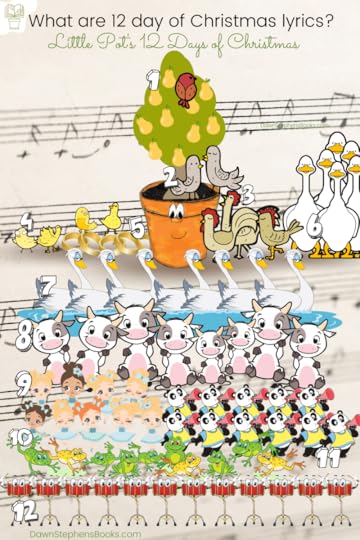 Little Pot’s 12 Days of Christmas LyricsHow many gifts in the 12 days of Christmas?
Little Pot’s 12 Days of Christmas LyricsHow many gifts in the 12 days of Christmas?The 12 days of Christmas can make for a fun math game of multiplication and addition. The gifts multiply each day, and are then added to the previous day. Therefore, by the end of the twelfth day, the recipient did not get one partridge in a pear tree, but 12 partridges in 12 pear trees. Moreover, the 9 ladies dancing given on the 9th day were given again on the 10th, 11th, and 12th day totaling 36 dancers dancing (9X4). 364 gifts were given and received once all the receptions are counted.
12 partridges in pear trees (1 X 12 days)22 turtle doves (2 X 11 days)30 French hens (3 X 10 days)36 calling birds (4 X 9 days)40 golden rings (5 X 8 days)42 geese a laying (6 X 7 days)42 swans a swimming (7 X 6 days)40 cows a milking (8 X 5 days)36 dancers dancing (9 X 4 days)30 frogs a leaping (10 X 3 days)22 pandas piping (11 X 2 days)12 drummers drumming (12 X 1 day)It can also be fun to graph each gift and compare the amounts. Most children do not realize that at the end of the 12 days there are more geese and swans than drummers.
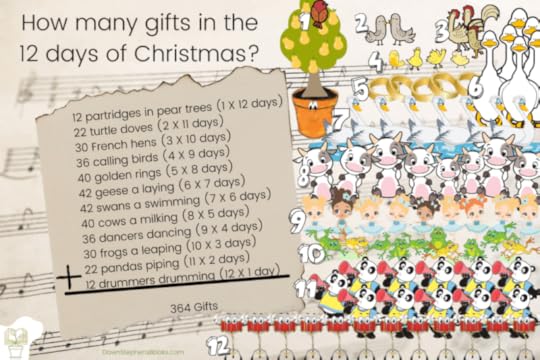 Counting the repetitions, there are 364 total gifts.
Counting the repetitions, there are 364 total gifts. The post What Does 12 Days of Christmas Mean to Creative Christians? appeared first on DawnStephensBooks.
December 1, 2021
How to Create an Easy DIY Holiday Ornament with Little Pot
Looking for DIY holiday ornament this Christmas? Coming up with a creative Christmas ornaments for your children to make and add to your tree each year can be a challenge. But, Little Pot has an idea to help you create ornaments and start a Christmas ornament tradition. He’s here to give you a step by step guide and template so you can add your own little pot to your Christmas tree this year and each year as your “little fruit pot” grows.
Christmas Tree Ornament Craft IdeasLittle Pot can be turned into all sorts of things at Christmas time. For example, if you turn a little pot upside down, you can find DIY holiday ornaments that look like snowmen, angels, reindeer, Santa, and even Christmas trees. You only need to search Pinterest to find an endless reservoir of creative ideas.
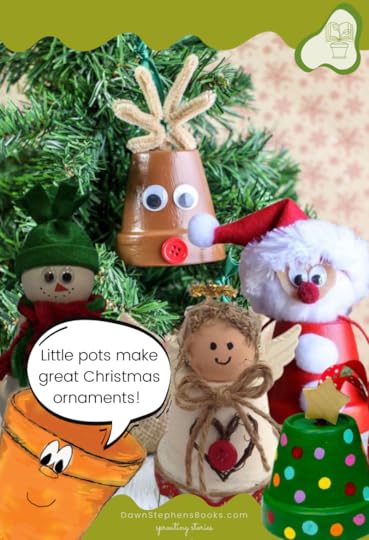 You can find a lot of ways to turn a small clay pot into a Christmas ornament.Begin your DIY Holiday Ornament by reading The Little Pot
You can find a lot of ways to turn a small clay pot into a Christmas ornament.Begin your DIY Holiday Ornament by reading The Little PotThe first step in making your ornament a special yearly addition is to read the story of The Little Pot. Each year, your child will learn that they were created for a special purpose. As they reread the story, they will see how Little Pot searches for its purpose. Likewise, we tend to search for our purpose again and again. So, reading this story over and over is a great reminder of why the potter (God) created us.
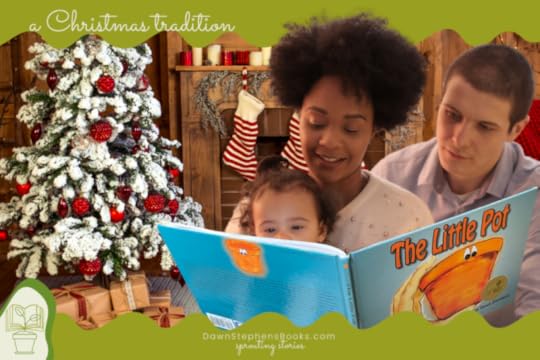 Begin by reading The Little Pot together.Imagine Ways you Grew the Fruit of the Spirit
Begin by reading The Little Pot together.Imagine Ways you Grew the Fruit of the SpiritAs Little Pot imagines all the different ways the potter can use it, similarly, your child can reflect on the different ways that our creator has used them. Have your child to think of ways that the fruit of the Spirit has grown through them this year and make a list. In addition, you can download this FREE fruit of the spirit chart to record their answers.
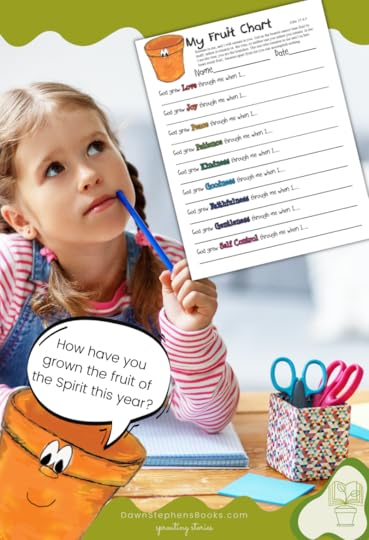 Use this FREE fruit of the Spirit chart to record how you have grown the fruit of the Spirit this year.A DIY Holiday Ornament with Little PotWatch how to make the little pot ornaments and how to put Christmas ornaments on the tree.Supplies for your DIY Holiday Ornament
Use this FREE fruit of the Spirit chart to record how you have grown the fruit of the Spirit this year.A DIY Holiday Ornament with Little PotWatch how to make the little pot ornaments and how to put Christmas ornaments on the tree.Supplies for your DIY Holiday OrnamentGather the following items to make a Little Pot ornament,
Googly eyesButtonsString or ornament hooksBlack Sharpie markerSmall clay pots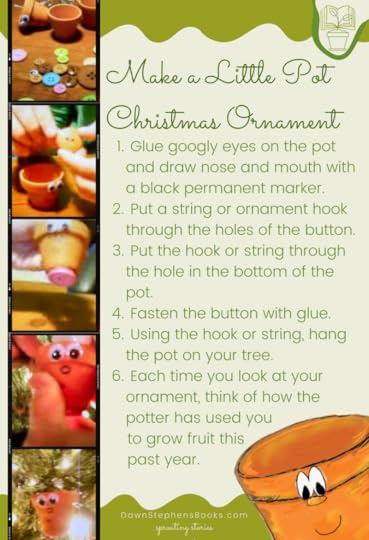 How to make a Little Pot Christmas tree ornament
How to make a Little Pot Christmas tree ornamentThen follow these steps:
Glue googly eyes on the clay pot and draw a nose and mouth with a black permanent marker.Put a string or ornament hook through the holes in a button.Put the hook or string through the hole in the bottom of the clay pot.Fasten the button to the bottom with glueUsing the hook or string, hang the pot on your tree.Each time you look at your ornament, think of how the potter has used you to grow fruit this past year.After you’ve made a Little Pot ornament, write the year with your sharpie marker on it. Then use your fruit chart and choose one thing you did the past year that was fruitful. Write it on a piece of paper and glue it inside of the ornament so each year , you’ll remember how the potter used you to grow fruit that year.
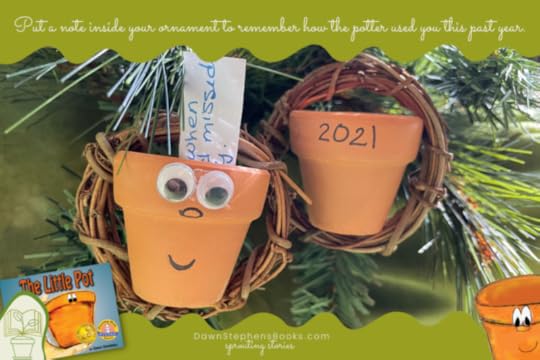 remember to write the year on your ornament and put a note inside to remember how the potter used you this past year
remember to write the year on your ornament and put a note inside to remember how the potter used you this past yearDo you want to know more about how Little Pot grows the fruit of the Spirit?
Sign up below and get our FREE fruit bearing lessons.
Get the FREE resource by registering here.The post appeared first on DawnStephensBooks.
November 18, 2021
Five Important Categories of Food that Jack Sprat Could Eat on Thanksgiving Day
Jack Sprat could eat no fat …
In the traditional nursery rhyme, the lyrics go like this:
Food at Thanksgiving DinnerJack Sprat could eat no fat.
His wife could eat no lean.
And so between them both, you see,
They licked the platter clean
-Mother Goose
When Planning your Thanksgiving dinner, it can be fun to think about what Jack and his wife could eat. The story, “Jack Sprat Learns About Food” helps children to learn about the different categories of food that we should include in our meals. To do this, we are going to use resources from myplate.gov.
If you are curious how we graduated from the “basic four food groups” to a “food pyramid” and then finally arrived at “myplate”, check out this blog for more information.
1. The Fruit Category – Jack Sprat Could Eat FruitThe first type of food that Jack and his wife need for their Thanksgiving dinner is fruit.
Foods that are in this category include any fruit or 100% fruit juice. The fruit can be fresh, frozen, canned, or dried. Most people will not have fruit juice for dinner. But, a fruit salad makes a colorful addition at a Thanksgiving meal.
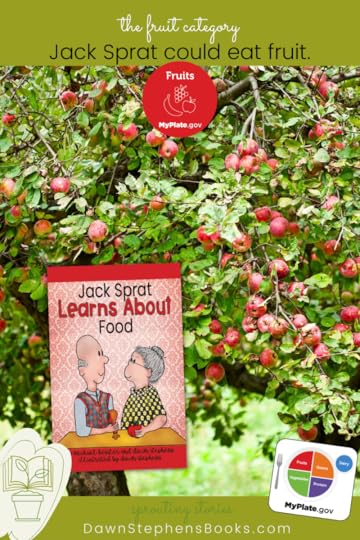 Jack Sprat could eat fruit.2. The Vegetable Category – Jack Sprat Could Eat Vegetables
Jack Sprat could eat fruit.2. The Vegetable Category – Jack Sprat Could Eat VegetablesThe second category that Jack and his wife could eat is vegetables. This category includes any vegetable or 100% vegetable juice. Vegetables can be raw or cooked, canned, frozen, or picked fresh. They can be cut up, mashed, or whole. All vegetables are not the same, however. You can put them in sub-categories of:
GreenRed and orangeBeans, peas, and lentilsStarchyOther vegetablesFor examples in each group and serving amounts for specific age groups go here. And, because we are talking about a Thanksgiving meal, it is ok to go overboard and try to serve a vegetable from each sub-category. Jack Sprat might include a green bean casserole, a sweet potato casserole, broccoli, corn, and Brussel sprouts.
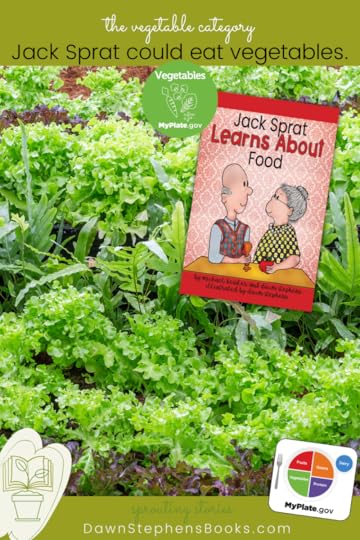 Jack Sprat could eat vegetables.3. The Grains Category
Jack Sprat could eat vegetables.3. The Grains CategoryThe third category is grains. This category includes wheat, rice, oats, cornmeal, and barley. The foods in this category are divided into 2 subgroups: Whole Grains and Refined Grains. Whole grains contain the entire grain kernel. Refined grains are crushed to create a finer texture and longer shelf life. But, refining the grain removes fiber, iron, and some vitamins. A refined grain is white flour, corn grits, white bread, and white rice. You can, however, find refined grains that are enriched with certain vitamins and iron.
Jack could include dinner rolls, bread, or pasta at his Thanksgiving meal so he and his wife would have an adequate serving of food from the grains category.
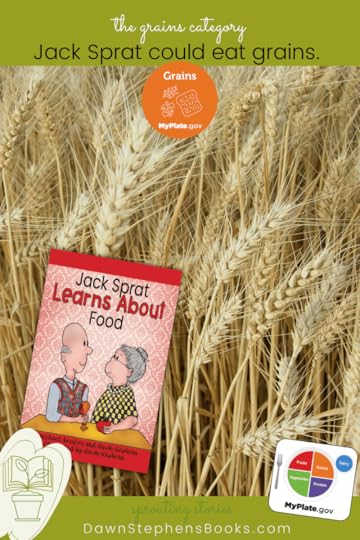 Jack Sprat could eat food from the grains.4. The Dairy Category
Jack Sprat could eat food from the grains.4. The Dairy CategoryThe dairy category provides us with calcium. It includes products made from milk. Examples are milk itself, ice-cream, yogurt, and cheese. Lactose-free milk and fortified soy milk are good options too. Plant based milk like almond or oat milk, is not a part of the dairy category. However, these “milks” can be a good source of calcium. Foods that are made from milk, but have little calcium and a high fat content, such as cream cheese, sour cream, cream, and butter would not be good choices of food in this category.
Jack’s Thanksgiving dinner might include Mac and Cheese, and a large glass of milk. I am sure he’d enjoy a scoop of ice-cream on his pumpkin pie too.
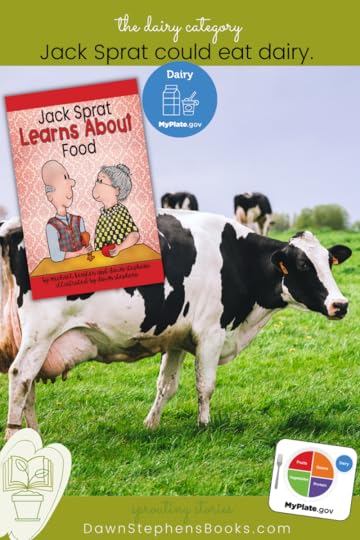 Jack Sprat could eat dairy.5. The Protein Category
Jack Sprat could eat dairy.5. The Protein Category The protein category might be little tricky for Jack and his wife. We tend to think of protein as something we get from meat. Back in the day we referred to this category as “the meat group.”
Seafood, meat, poultry, eggs, beans, peas, and lentils, nuts, seeds, and soy products are all a part of the Protein Category. Even though beans, peas, and lentils are also part of the Vegetable Category. And just like Jack Sprat, (who ate no fat) our meat and poultry choices should be lean or low-fat too. But remember Jack;s wife? She would not eat even lean meat. We might, therefore, assume that Jack’s wife was a vegetarian (a person that does not eat meat). In the little book, “Jack Sprat Learns About Food“, Jack helps his wife by presenting her with nuts and beans, so she will have a source of protein. Vegetarian options in the Protein Category include beans, peas, and lentils, nuts, seeds, and soy products.
It is a good idea to have some vegetarian options available at your Thanksgiving dinner. You can find a lot a vegetarian recipes on line.
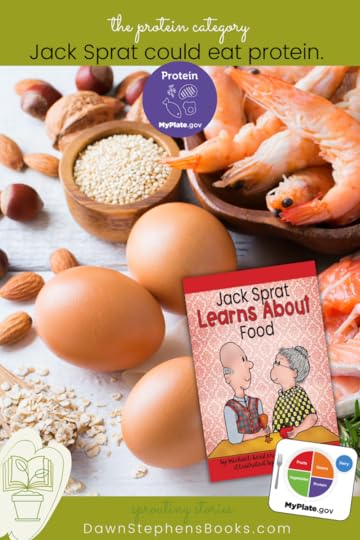 Jack Sprat could eat protein.Nursery Rhyme Jack Sprat
Jack Sprat could eat protein.Nursery Rhyme Jack SpratIf you searching for easy-to-read text that can help your preschoolers, kindergarteners, or first-grade students learn about good nutrition, you will want the creative teaching resource: “Jack Sprat Learns About Food.” Dawn Stephens has masterfully created a resource that contains new lyrics to the Mother Goose rhyme of Jack Sprat. Your students will memorize the text with ease and then be able to track the words in the book. Therefore, this printable guided reading book and PowerPoint eBook Show will help students learn to read too.
This resource is available Teachers Pay Teachers.
Get a food category worksheet to help you remember.Sign up for a FREE myplate.gov
The post Five Important Categories of Food that Jack Sprat Could Eat on Thanksgiving Day appeared first on DawnStephensBooks.
November 3, 2021
How to Let your Light Shine Astoundingly Without Being too Bright
“Let your light shine” sounds like a great saying. To young students, however, it can be confusing. Children think literally and understanding how to let their light shine can be a difficult concept to teach.
Let your light shine, Matthew 5In Matthew chapter 5 Jesus tells us that we are to be the light of the world. He explains that a city set on a hill cannot be hidden and that people do not light a lamp and then put it under a bowl. Instead, they set it up high on a lampstand so it will give light to all in the house. He then goes on to say that we are to let our lights shine in the same way.
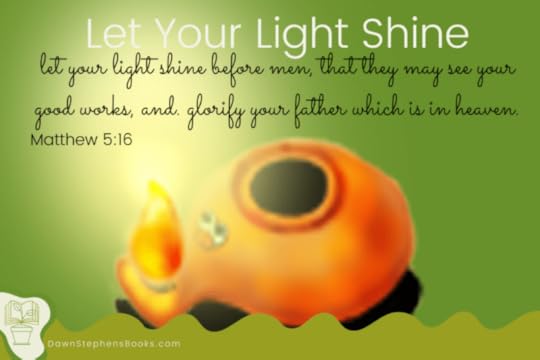 Let your light shine. Matthew 5:16Let your light shine, Matthew 5:16
Let your light shine. Matthew 5:16Let your light shine, Matthew 5:16In the same way, let your light shine before others so that they may see your good works and give glory to your Father in heaven.
-Matthew 5:16
Considering a city on a hill and a lamp on a lampstand, you realize that shining your light is for the purpose of others seeing you. But not just YOU! What others should see if your good works. And not for the purpose of self-recognition, but for the purpose of glorifying God.
When was oil lamp invented?To put into context these verses, it helps to know what sources of light people had. Oil lamps would have been the common light fixtures of that time. The oil lamp was invented long before Christ came to earth. That is to say, there are archaeological finds that date oil lamps back to ancient times. After I traveled to Israel and studied what oIl lamps looked liked when Jesus was a little boy, I was shocked at how small they were. They were tiny clay vessels that fit in the palm of your hand. I guess they would have used them like flashlights or phone lights.
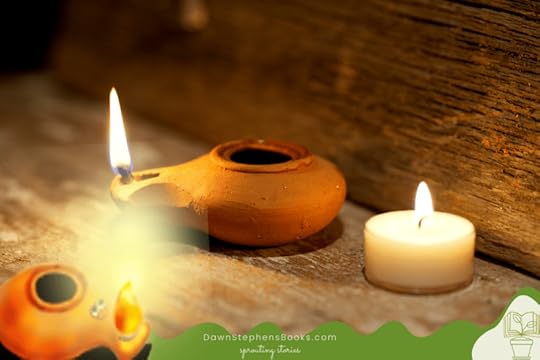 An ancient oil lamp was a small clay vessel that could fit in the palm of your hand.
An ancient oil lamp was a small clay vessel that could fit in the palm of your hand.The Little Pot and The Tea Pot books were already a huge success. Therefore, I decided that an OIl Lamp would be a great addition to the vessels the potter creates in his workshop.
How to let your light shine? – Be courageous!In developing the plot, I thought about how children would understand how they are to let their light shine. What problems might this little vessel face? The first is the one that Jesus addresses when He says that we do not light a lamp and hide it under a bowl. The first step is to be brave and willing to share Jesus with others. The Bible commands us to be courageous in several places.
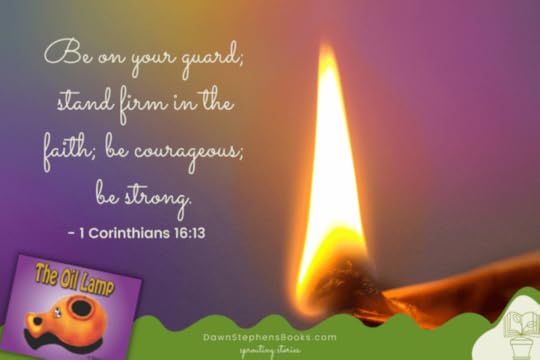 Bible verse on CourageBible Verses on Courage
Bible verse on CourageBible Verses on CourageBe strong and courageous. Do not be afraid … for the Lord goes with you; he will never leave you nor forsake you.
-Deuteronomy 31:6
Have I not commanded you? Be strong and courageous. Do not be afariad; do not be discouraged, for the Lord your God will be with you wherever you go.
-Joshua 1:9
Be on your guard; stand firm in the faith; be courageous; be strong.
-1 Corinthians 16:13
For God has not given us spirit of fear and timidity, but of power, love, and self-discipline.
-2 Timothy 1:7
you can find more here.
Light shines brighter in the darkThe opposite of light is dark. Darkness was never created by God. It is simply the absence of light. As they understand that light represents God and that if they are brave enough to share Jesus, they can recognize “darkness” or areas where God is absent. Helping children learn what is ungodly is as important as helping them to discover what is godly. Formulating a discussion on this topic will help to discover your child’s spiritual growth.
 lights shine the brightest in the darkHow bright should you let your light shine?
lights shine the brightest in the darkHow bright should you let your light shine?Can you shine your light too bright? This is the next problem that Oil Lamp faces in the story. Once he discovers that others are attracted to the light the potter has given him, he ignites with pride. He pushes his flame bigger and the other vessels feel the heat. The heat becomes so intense that they feel burned and are forced to turn away from the light. This is what happens when we share the gospel without gentleness. When we do not give the Holy Spirit time to work. We have to be careful that we do not drive others away from Christ by appearing judgemental and unloving.
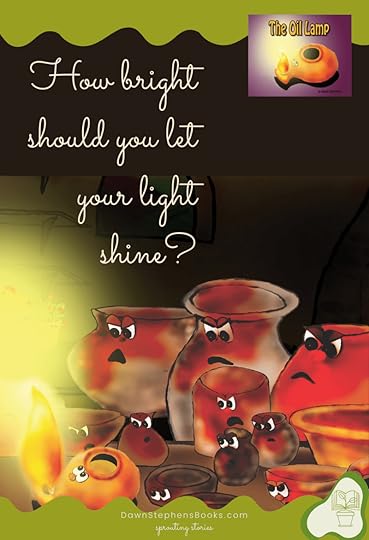 We can make others feel judged if we force our light on them.Encouraging to others
We can make others feel judged if we force our light on them.Encouraging to othersOil Lamp’s flame has been extinguished twice. Firstly, by his own fear. Secondly, by others who reject him. Tea Pot and Little Pot encourage the little lamp. How do they encourage one another? The same way that we do. By sharing our own stories and how the potter has worked in our lives. Tea Pot knows what it is to serve and Little Pot knows how good the potter truly is. They did not always know that, however. Their experiences taught them. When they share their stories with Oil Lamp, he gains faith again and is ready to shine.
Only the potter can light the wickEven though OIl Lamp is ready to shine again, it must wait for the potter to return and light it. It is important to remember that we cannot light ourselves. When the world tells our children to shine, they also tell them that the light is something that comes from within them. Jesus is the light, however, and while He created all of us in His image, we are not always a good reflection of HIm. Think back to our verse in Matthew above. When our light shines it allows others to see our good works and give glory to God. The light is not the good works we do. It is what allows others to see the good works. It is a reflection of God being in our lives and the reason we do good things. We shine for God’s glory, not our own.
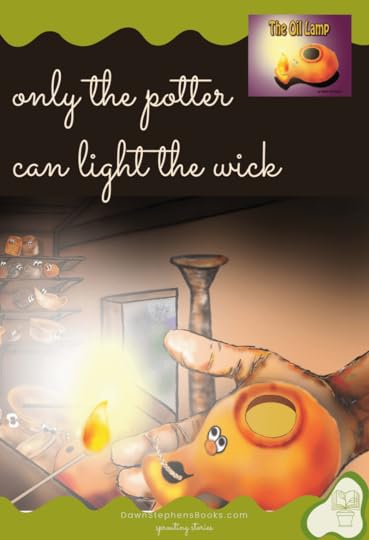 We cannot ignite our own lights. The light we shine should come from God.What is a lampstand?
We cannot ignite our own lights. The light we shine should come from God.What is a lampstand?Finally, at the end of the story, the potter gives light back to the Oil Lamp and places it above the other vessels on a lampstand. A lampstand is a pillar, tripod, or stand to support or hold a lamp. Therefore, on the lampstand, the oil lamp can give the most light. It is above the darkness and separated from the mischief that the other vessels revel in. Similarly, we know that separating ourselves from mischief is important. We sometimes believe we have to be right in the middle of darkness and sin to shine. However, Jesus explains in Matthew that a city on a hill or lamp upon a lampstand is better seen and able to burn the brightest.
Oil lamp coloring pageGet a FREE Oil Lamp Coloring Page here.The post How to Let your Light Shine Astoundingly Without Being too Bright appeared first on DawnStephensBooks.

